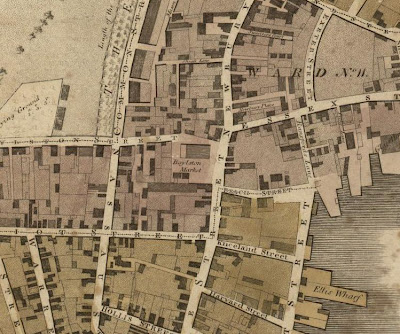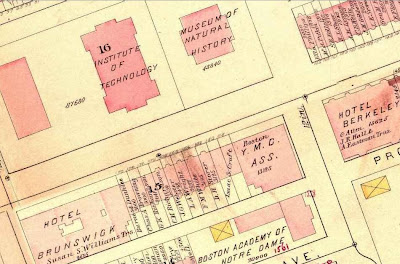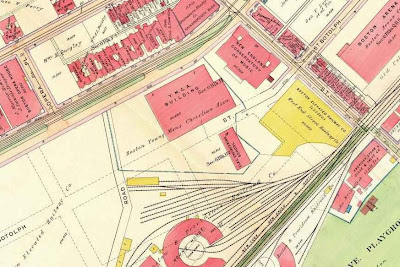
The original Continental Clothing House building, at Washington and Harvard streets.
The Continental Clothing House, or Freeland, Loomis and Company, was founded in 1873. The store was preceded by the C.W. Freeland, Beard and Company, located at 152 Devonshire street, as revealed by the 1865 Boston Directory. At the same time, Silas Loomis was having success in business in in the Midwest. After the Chicago Fire of 1871, Loomis came to Boston and joined the firm Freeland, Loomis and Company. The first location of the new store was 744-756 Washington street. This was at the corner of Harvard street, which was one block south of Kneeland street. The contemporaneous print above boasts "The Largest Retail Clothing House in New England."
"King's Handbook of Boston said:
"The first place of business in this country to make use of the electric light was the Continental Clothing House, at the south-west corner of Washington and Harvard Streets ; the proprietors, Freeland, Loomis, & Co., successfully making the experiment Nov. 14, 1878. In 1881 the light was introduced in illuminating Scollay Square and a section of Court Street at night; and it was also employed in a number of hotels, shops, and large establishments. Its general introduction in the street-lighting of the city has since been carried forward. "

Before I go on to the second location of the Continental Clothing House in Boston, this might be the appropriate place to insert mention of the Omaha branch store. Presumably based on Silas Loomis' experience in the West, the
Omaha Illustrated of 1888 reported: "
The proprietors of the establishment have fixed upon Omaha as the most important point for the western distributing branch of their business, and will eventually transfer a large portion of their manufacturing to this city, where, in the near future, it is proposed to enter into competition with the large western wholesale markets of Chicago and St. Louis in supplying the demand of the great West and Northwest, which must look to Omaha for its supplies of every description."
Evidently, Freeland and Loomis were thinking big. The Omaha Illustrated article also informs us that the stock for the store would be manufactured in Boston by between by "between five and six hundred hands," at the home facility. That's interesting. I take from that reference that the stock sold at the Boston store had been made on the premises as well.

The new building, at the corner of Boylston and Washington streets.

From an advertisement, Boston Globe, December 7, 1923.
Back to Boston. In 1888, the store moved up Washington street to the corner of Boylston street, on the site of the old Boylston Market (more on that building in a future entry).

Advertisement from The Tech, newspaper of the Massachusetts Institute of Technology, December 10, 1896.

Another advertisement from The Tech, the newspaper of the Massachusetts Institute of Technology, March 30, 1917. Stylish, aren't they?

Promotional pin from the Continental Clothing House.

The trade card for the Continental Clothing House shows, on opposite sides (above and below) the difference between your average suitor and the well dressed man.

On September 7, 1923, a Boston Globe article announced that the Continental Clothing House, under the name Freeland Loomis Company, had been bought by William Filene's Sons Company. Both the main Boylston street store and a newer store at Washington and Franklin streets were included in the sale. So now we know what happened to this major Boston retail institution. At least we know what happened to the name. I still don't know what Filene's did with the Boylston street location, and how long it remained as a retail establishment.
 Boylston Market, BPL Flickr photo group. No overhead wires for streetcars, so perhaps 1880s.
Boylston Market, BPL Flickr photo group. No overhead wires for streetcars, so perhaps 1880s. This photo dated 1881-1883. BPL Flickr photo group.
This photo dated 1881-1883. BPL Flickr photo group. Title: Corner of Washington and Boylston Streets, Boston. The old Boylston Market, Published in: Ballou's pictorial drawing-room companion, unknown date (possibly mid-1850s) BPL Flickr photo group.
Title: Corner of Washington and Boylston Streets, Boston. The old Boylston Market, Published in: Ballou's pictorial drawing-room companion, unknown date (possibly mid-1850s) BPL Flickr photo group. The then-new Boylston Market, 1813. At the corner of Boylston and Orange (later Washington) streets (click on map for larger image).
The then-new Boylston Market, 1813. At the corner of Boylston and Orange (later Washington) streets (click on map for larger image). Near the end: Boylston Market, 1883.
Near the end: Boylston Market, 1883.














